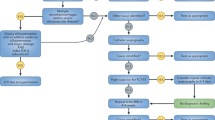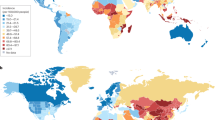Abstract
Data on incidence of intracerebral haemorrhage (ICH) vary widely. Population-based data on predictors of ICH survival and functional outcome are rare. The Ludwigshafen Stroke Study is a prospective, population-based stroke registry which started in January 2006. All residents of the city of Ludwigshafen, Germany, who suffer from acute stroke or transient ischaemic attack are registered. Patients with first-ever primary intracerebral haemorrhage (FE-pICH) between 2006 and 2010 were included in the present analysis. Between January 1st, 2006 and December 31st, 2010, 152 patients suffered a FE-pICH. Crude and age-adjusted incidence rates per 100,000 for FE-pICH were 18.7 (95 % CI 15.9–21.9) and 11.9 (95 % CI 10.2–14.0), respectively, and remained stable over time. Case-fatality rates for FE-pICH were 27.0, 34.9 and 44.1 % at days 28, 90 and 365, respectively. In 21 patients, an (21.3 %) early do-not resuscitate-order was documented. Excluding these patients from multivariate analyses, National Institute of Health Stroke Scale (NIHSS) (OR 1.22, 95 % CI 1.08–1.36), hypercholesterolemia (OR 0.16, 95 % CI 0.05–0.55) and modified Rankin Scale (mRS) prior to stroke (OR 1.56, 95 % CI 1.06–2.3) were independently associated with risk of 1-year mortality, whereas NIHSS (OR 1.41, 95 % CI 1.20–1.66) and leukocyte count on admission (OR 1.48, 95 % CI 1.16–1.89) were independently associated with good or moderate functional outcome (mRS ≤ 3) after 1 year. Incidence of FE-ICH is in the lower range of those reported from other registries and remained stable over the observation period. Higher treatment rates for hypertension might partly account for this. Stroke severity as indicated by NIHSS was independently associated with mortality and functional outcome after 1 year. We found no association between aetiology and outcome in ICH patients.

Similar content being viewed by others
References
Qureshi AI, Mendelow AD, Hanley DF (2009) Intracerebral haemorrhage. Lancet 373:1632–1644
Broderick J, Brott T, Tomsick T, Tew J, Duldner J, Huster G (1994) Management of intracerebral hemorrhage in a large metropolitan population. Neurosurgery 34:882–887 (discussion 887)
Weimar C, Weber C, Wagner M et al (2003) Management patterns and health care use after intracerebral hemorrhage. A cost-of-illness study from a societal perspective in Germany. Cerebrovasc Dis 15:29–36
van Asch CJ, Luitse MJ, Rinkel GJ, van der Tweel I, Algra A, Klijn CJ (2010) Incidence, case fatality, and functional outcome of intracerebral haemorrhage over time, according to age, sex, and ethnic origin: a systematic review and meta-analysis. Lancet Neurol 9:167–176
Palm F, Urbanek C, Rose S et al (2010) Stroke incidence and survival in Ludwigshafen am Rhein, Germany: The Ludwigshafen stroke study (LuSSt). Stroke 41:1865–1870
Wolfe CD, Giroud M, Kolominsky-Rabas P et al (2000) Variations in stroke incidence and survival in 3 areas of Europe. European registries of stroke (EROS) collaboration. Stroke 31:2074–2079
Donnan GA, Hankey GJ, Davis SM (2010) Intracerebral haemorrhage: a need for more data and new research directions. Lancet Neurol 9:133–134
Feigin VL, Lawes CM, Bennett DA, Barker-Collo SL, Parag V (2009) Worldwide stroke incidence and early case fatality reported in 56 population-based studies: a systematic review. Lancet Neurol 8:355–369
Steiner T, Petersson J, Al-Shahi Salman R et al (2011) European research priorities for intracerebral haemorrhage. Cerebrovasc Dis 32:409–419
Lovelock CE, Molyneux AJ, Rothwell PM (2007) Change in incidence and aetiology of intracerebral haemorrhage in Oxfordshire, UK, between 1981 and 2006: a population-based study. Lancet Neurol 6:487–493
Meretoja A, Strbian D, Putaala J et al (2012) SMASH-U: a proposal for etiologic classification of intracerebral hemorrhage. Stroke 43:2592–2597
Hatano S (1976) Experience from a multicentre stroke register: a preliminary report. Bull World Health Organ 54:541–553
Rothwell PM, Coull AJ, Giles MF et al (2004) Change in stroke incidence, mortality, case-fatality, severity, and risk factors in Oxfordshire, UK from 1981 to 2004 (Oxford Vascular Study). Lancet 363:1925–1933
Goldstein LB, Bertels C, Davis JN (1989) Interrater reliability of the NIH stroke scale. Arch Neurol 46:660–662
Teasdale G, Jennett B (1974) Assessment of coma and impaired consciousness. A practical scale. Lancet 2:81–84
Rankin J (1957) Cerebral vascular accidents in patients over the age of 60. II. Prognosis. Scott Med J 2:200–215
The sixth report of the Joint National Committee on prevention, detection, evaluation, and treatment of high blood pressure. Arch Intern Med (1997) 157: 2413–2446
Balkau B (2000) The DECODE study. Diabetes epidemiology: collaborative analysis of diagnostic criteria in Europe. Diabetes Metab 26:282–286
Palm F, Urbanek C, Wolf J et al (2012) Etiology, risk factors and sex-differences in ischemic stroke in the Ludwigshafen Stroke Study (LuSSt), a population-based stroke registry. Cerebrovasc Dis 33:64–68
Kothari RU, Brott T, Broderick JP et al (1996) The ABCs of measuring intracerebral hemorrhage volumes. Stroke 27:1304–1305
Malmgren R, Warlow C, Bamford J, Sandercock P (1987) Geographical and secular trends in stroke incidence. Lancet 2:1196–1200
Bonita R, Broad JB, Anderson NE, Beaglehole R (1995) Approaches to the problems of measuring the incidence of stroke: the Auckland Stroke Study, 1991–1992. Int J Epidemiol 24:535–542
Sudlow CL, Warlow CP (1996) Comparing stroke incidence worldwide: what makes studies comparable? Stroke 27:550–558
Doll R, Cook P (1967) Summarizing indices for comparison of cancer incidence data. Int J Cancer 2:269–279
Benatru I, Rouaud O, Durier J et al (2006) Stable stroke incidence rates but improved case-fatality in Dijon, France, from 1985 to 2004. Stroke 37:1674–1679
Arima H, Tzourio C, Anderson C et al (2010) Effects of perindopril-based lowering of blood pressure on intracerebral hemorrhage related to amyloid angiopathy: the PROGRESS trial. Stroke 41:394–396
Fogelholm R, Murros K, Rissanen A, Avikainen S (2005) Long term survival after primary intracerebral haemorrhage: a retrospective population based study. J Neurol Neurosurg Psychiatry 76:1534–1538
Kolominsky-Rabas PL, Sarti C, Heuschmann PU et al (1998) A prospective community-based study of stroke in Germany–the Erlangen Stroke Project (ESPro): incidence and case fatality at 1, 3, and 12 months. Stroke 29:2501–2506
Ronning OM, Guldvog B, Stavem K (2001) The benefit of an acute stroke unit in patients with intracranial haemorrhage: a controlled trial. J Neurol Neurosurg Psychiatry 70:631–634
Zahuranec DB, Morgenstern LB, Sanchez BN, Resnicow K, White DB, Hemphill JC 3rd (2010) Do-not-resuscitate orders and predictive models after intracerebral hemorrhage. Neurology 75:626–633
Creutzfeldt CJ, Becker KJ, Weinstein JR et al (2011) Do-not-attempt-resuscitation orders and prognostic models for intraparenchymal hemorrhage. Crit Care Med 39:158–162
Woo D, Kissela BM, Khoury JC et al (2004) Hypercholesterolemia, HMG-CoA reductase inhibitors, and risk of intracerebral hemorrhage: a case-control study. Stroke 35:1360–1364
Silva Y, Leira R, Tejada J, Lainez JM, Castillo J, Davalos A (2005) Molecular signatures of vascular injury are associated with early growth of intracerebral hemorrhage. Stroke 36:86–91
Palm F, Kleemann T, Dos Santos M et al (2013) Stroke due to atrial fibrillation in a population-based stroke registry (Ludwigshafen Stroke Study) CHADS(2), CHA(2) DS(2) -VASc score, underuse of oral anticoagulation, and implications for preventive measures. Eur J Neurol 20:117–123
Cucchiara B, Messe S, Sansing L, Kasner S, Lyden P (2008) Hematoma growth in oral anticoagulant related intracerebral hemorrhage. Stroke 39:2993–2996
Fang MC, Go AS, Chang Y et al (2012) Thirty-day mortality after ischemic stroke and intracranial hemorrhage in patients with atrial fibrillation on and off anticoagulants. Stroke 43:1795–1799
Palm F, Santos MD, Urbanek C et al (2013) Stroke seasonality associations with subtype, etiology and laboratory results in the Ludwigshafen Stroke Study (LuSSt). Eur J Epidemiol 28:373–381
van Beijnum J, Lovelock CE, Cordonnier C, Rothwell PM, Klijn CJ, Al-Shahi Salman R (2009) Outcome after spontaneous and arteriovenous malformation-related intracerebral haemorrhage: population-based studies. Brain 132:537–543
Knudsen KA, Rosand J, Karluk D, Greenberg SM (2001) Clinical diagnosis of cerebral amyloid angiopathy: validation of the Boston criteria. Neurology 56:537–539
Acknowledgments
Data analysis was supported by a grant from the Deutsche Forschungsgemeinschaft (DFG; GR1102/6-1). LuSSt is part of the German Competence Network Stroke.
Conflicts of interest
None.
Ethical standard
This study has been approved by the appropriate ethics committee and has therefore been performed in accordance with the ethical standards laid down in the 1964 Declaration of Helsinki.
Author information
Authors and Affiliations
Corresponding author
Rights and permissions
About this article
Cite this article
Palm, F., Henschke, N., Wolf, J. et al. Intracerebral haemorrhage in a population-based stroke registry (LuSSt): incidence, aetiology, functional outcome and mortality. J Neurol 260, 2541–2550 (2013). https://doi.org/10.1007/s00415-013-7013-0
Received:
Revised:
Accepted:
Published:
Issue Date:
DOI: https://doi.org/10.1007/s00415-013-7013-0




